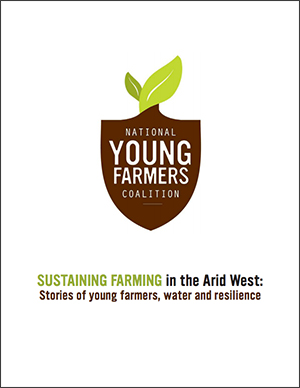These case studies of six farmers in four Colorado River Basin states highlight innovative drought mitigation and resilience in the Arid West.
PRESS RELEASE
Farmers adapt to drought and increase productivity
New case studies highlight innovative drought mitigation & water savings
by six farmers in four Colorado River Basin states
DURANGO, CO (Aug. 14, 2014) – The National Young Farmers Coalition released a report today highlighting innovative farmers who are adapting to record drought in the arid Southwest. “Sustaining Farming in the Arid West: Stories of young farmers, water and resilience” demonstrates how Western farmers are saving water, stewarding the land and enhancing productivity in increasingly dry times.
“All too often, water is taken off the land for growing cities at the expense of agriculture, the health of the land and the economic vitality of rural communities,” said Kate Greenberg, Western Organizer for the National Young Farmers Coalition. “Irrigated agriculture is central to our communities in the Southwest. We need to keep it productive, vibrant and viable for today and the generations ahead while responding to existing and future pressures on our limited water supply. We all have a shared responsibility to protect this critical resource, and these farmers are helping lead the way.”
Highlights from the report, which profiles farmers from Arizona, Colorado, New Mexico and Utah, include:
- Marana, AZ: Jason Walker, cotton-turn-grain farmer. Walker irrigates through a combination of wells and surface water provided by the Central Arizona Project, which delivers water from the Colorado River. Spurred by drought, Walker laser-leveled 175 acres of his 2,850-acre operation, a practice noted to be 20-30% more water efficient. Walker is lining ditches, reducing run-off and utilizing conservation tillage to save water, retain topsoil, and enhance his grain crops and what remains of his cotton crop. As Walker says, “It’s absolutely our responsibility to conserve our finite resources. Farming takes everyone. We are all in this together and we have to protect the opportunity for the future.”
- Bosque Farms, NM: Mike De Smet, organic, raw dairy farmer. In response to drought, De Smet laser-leveled all his fields and transitioned to no- and minimum-till planting to support the productivity of his herd and save water. Mike says, “We have changed our entire operation due to the lack of water. Our planting dates have changed, double cropping wheat and corn have stopped, and we are planting shorter maturity date varieties.” By enhancing his irrigation efficiency and stewardship, Mike expects to grow his herd to full capacity—around 100 head—in the next five years while simultaneously saving water.
- San Luis Valley, CO: Brendon Rockey, certified seed and specialty potato grower. When drought hit hard seven years ago, Rockey replaced his barley rotation with a cover crop. Not only did this reduce that years’ water use, but also reduced the water needs of the following potato harvest as the cover crop retained moisture in the soil throughout the year. His healthy soil also enhanced the effectiveness of his center pivot irrigation. In the last seven years, Rockey’s pumping costs from the shallow aquifer have decreased—his cumulative annual consumptive use cut nearly in half—while his crop quality increased. What income he lost from his barley crop he more than makes up for in reduced input expenses due to enhanced nutrient availability in healthy soil. His neighbors now come to him for advice on maintaining a productive business through drought. As Rockey says, “Farmers need to become biologists again,” as supporting life in the soil builds resilience.
Background
The Colorado River is one of the most dammed, diverted and in-demand rivers in the world. From its headwaters in the Rockies to its dry Delta, the Colorado travels through seven states, two countries and brings water to over 36 million people. In addition, it provides irrigation for nearly one fifth of our nation’s produce, including 80% of winter vegetables. Now entering its 14th year of drought, residents of the Colorado River Basin face challenging questions of what kind of West we want and can sustain.
The agriculture industry is the largest user of water in the West, consuming over 70% of surface water. As precipitation patterns shift, climate trends lean toward hotter, drier times, and cities continue to grow, many are looking to farmland for new supplies of water.
But taking agriculture out of the West is not the answer. Alternatives to what is known as “buy-and-dry,” or buying water from agriculture, which leaves the land unproductive, exist. These alternatives promote a vibrant agricultural economy and land that is being made better for the next generation of farmers and ranchers who grow our food.
It is a Herculean achievement that farmers and ranchers are able to save water while enhancing productivity in a period of unprecedented drought. As stewards making a life and a living off the land, these producers are exploring solutions to some of the most daunting challenges facing the Colorado River Basin and the West as a whole. It is time we work together as farmers and ranchers lead in the innovation and stewardship of the Wests’ most valuable resources.
###
